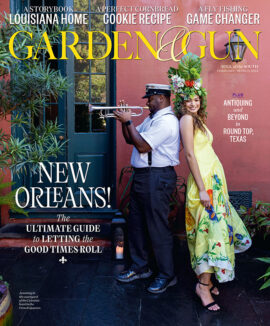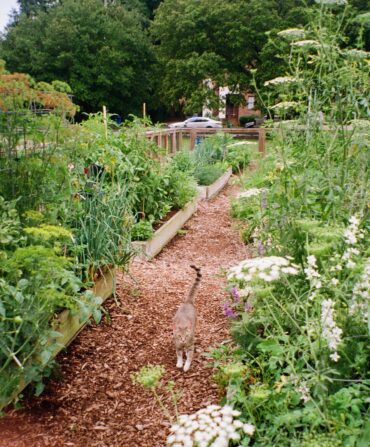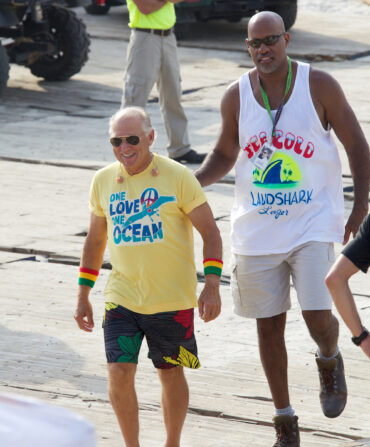“This shell right here was given to me by my grandfather,” Beth Collier says as she picks up a bleached white oyster the size of a salad plate, its ridges smoothed by decades of tumbling in the North Carolina surf. If she had to leave in a hurry, she says, “I would grab it before I grabbed my jewelry.” Nearby hangs a map tattooed with circles that mark the same grandfather’s favorite fishing holes in the marshes and tidal creeks of the Pamlico River. A five-foot-tall pecan stump that Beth and her husband hauled from a construction site sits in the corner of the breakfast room.
Each room in the home of Beth and Chris Collier is like this, layered with objects chosen for their looks, yes, but also for their stories and sentimental value. All the more fitting when you consider the couple’s connection to the home itself.
Locals in Washington, North Carolina, remember the building as Tayloe Hospital, a place where three generations of Down East doctors, including Chris’s maternal grandfather and great-grandfather, saw life come into the world and leave it, too. After a new facility was built in the fifties, Tayloe was converted into a nursing home. Beth’s grandmother spent her final years there.
But when the Colliers bought the property in 2004, the building had been boarded up for more than a decade, and the interior was in a sad, spooky state of disrepair. Caved-in ceilings, empty hospital beds, dusty slippers, and stained walls greeted them during their first walkthroughs. The attic was the worst. “We went up there with a flashlight,” Beth remembers. “There were hundreds of dead pigeons. It was terrifying. Very Alfred Hitchcock.”
But where others might have seen, well, pigeons, the Colliers saw promise. They were enamored with the structure’s Georgian architectural details and the fact that the property was in the town’s historic district on a lot the size of a public park. “We saw it as something worthy of saving,” Beth says.
Beth grew up in Washington and Chris in nearby Kinston, both in families rooted in eastern North Carolina’s once-bustling tobacco trade. Together, the couple moved back to Washington in the nineties following careers in the arts. Beth worked as a museum curator before starting her own interior design business. Chris was an antiques dealer. Their interest in the hospital was twofold. For starters, they didn’t want this piece of their town’s history in the hands of a rogue developer; second, they saw a unique opportunity to house their work and their home under one roof.
They started the project with major demolition, tearing down an unsightly mid-century addition to the side facade, removing walls that once divided patient rooms, and pulling up layers of cheap institutional tile. They turned the former ambulance entrance into their front door, carved out a section of the first floor for Beth’s design office, and transformed the second floor into living space for themselves, their two sons, Hawes and Beck, and their Labradoodle, Kippa. The third floor of the building was gutted and turned into a studio for their latest design endeavor, a furniture line called vanCollier. The couple cordoned off two separate residences in the building’s remaining square footage.

Photo: Patricia Lyons
Extra-long purple taper candles were chosen for the antique sconces.
Beth’s first endeavor after the interior framework was secured was to strip and cure the concrete floors, achieving a texture similar to terrazzo. The project took longer than two months. “You should have seen my arm muscles when I was finished,” she says. The couple left in place the old hospital elevator, in working condition despite years of neglect.

Photo: Patricia Lyons
The red entry hall, a tribute to the designer Albert Hadley.
In the entry, Beth opted for red lacquered walls to add warmth to an area that didn’t get much natural light. The choice was a tribute to the Tennessee-born designer Albert Hadley. “I adore the famous red entry in his New York City apartment,” she says. In the kitchen, the avid cooks installed commercial-grade shelving in lieu of built-in cabinetry. Pedigreed paintings left over from Chris’s days as an auctioneer mingle with childhood drawings by the couple’s sons. Oyster shells, sharks’ teeth, and dried palm fronds are displayed throughout the home in heirloom china compotes and silver baby cups passed down for generations. On a table in the living room sits an ancient bust plucked from the bottom of the Aegean Sea by Chris’s father, a souvenir from a diving trip when he worked as a buyer for R. J. Reynolds Tobacco in Turkey.
Pieces from the couple’s furniture line also dot the rooms—the cowhide chairs and the gilded iron tables in the living room are made upstairs in the third-floor studio. That is where the Colliers spend most of their days—drawing, sanding, and painting in what was once an operating room, boxing up pieces for shipment, and sending them down the elevator to trucks idling at the curb.
“I think about what would have been built here if we hadn’t come along,” Beth says as she leaves the studio on her commute to the kitchen to make dinner. “Chris’s family worked here. What was once their workplace is now our workplace. I love that.”









